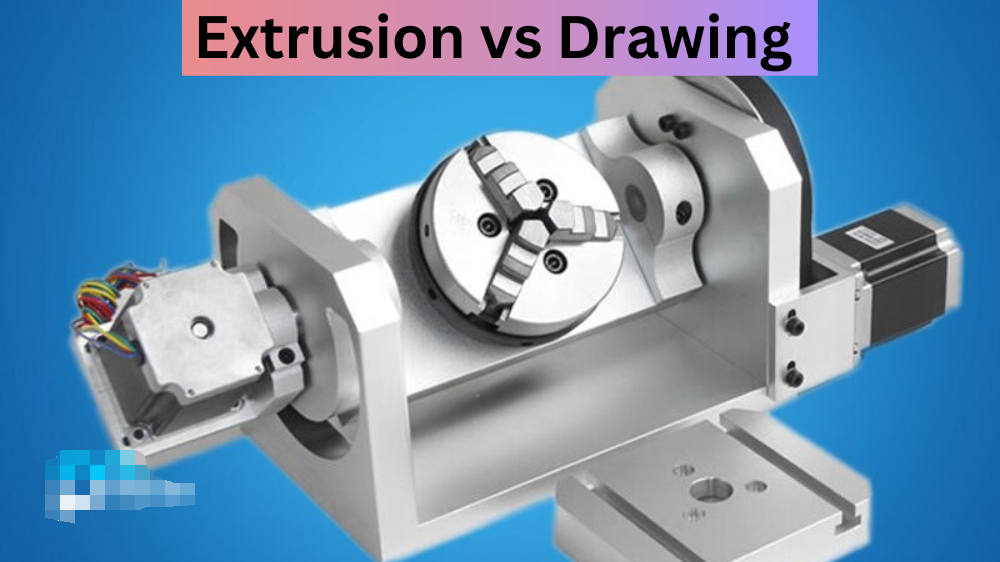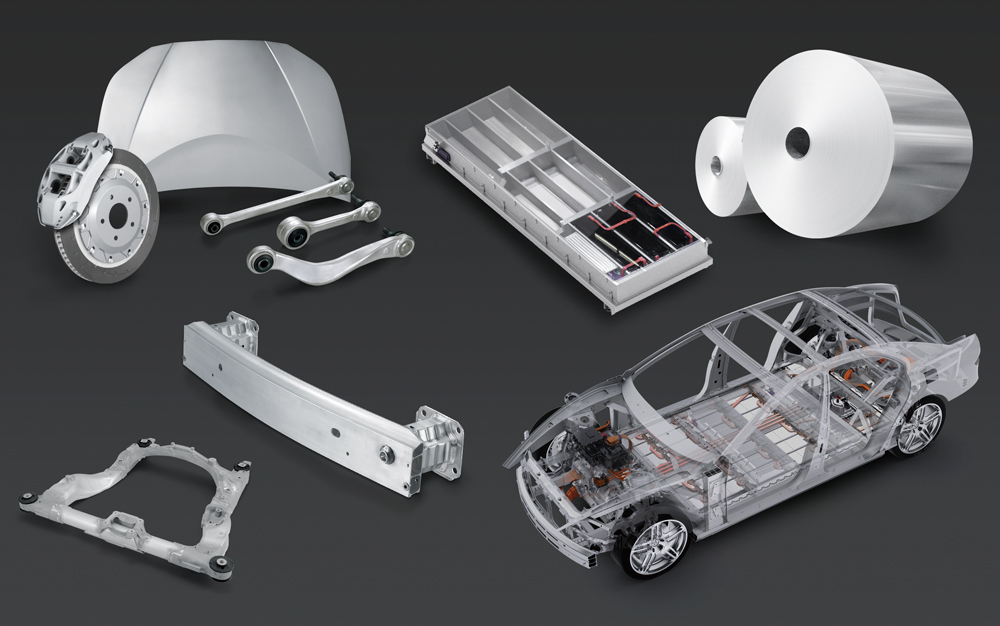Extrusion pushes material through a die to shape it, while drawing pulls material, reducing its cross-sectional area.

Fundamentals of Extrusion
Definition and Basics
Extrusion is a manufacturing process in which a material, often in the form of a billet or preform, is forced through a die to create a desired cross-sectional profile. The resultant product, which can be a rod, tube, or complex profile, retains the shape of the die as it cools and solidifies. Commonly, materials such as plastics, metals like aluminum, and even foodstuff can be extruded.
Types of Extrusion
Direct Extrusion
Also known as forward extrusion, direct extrusion is the most common method. Here, the material billet is placed in a container and is pushed through a stationary die using a hydraulic or mechanical press. As the billet moves, it takes the shape of the die opening. However, there are some challenges, such as a high force requirement due to the friction between the billet and container walls. For an aluminum profile of 100mm x 100mm, the typical extrusion speed might be around 50mm/s, with a force requirement of 2000kN.
Indirect Extrusion
In indirect extrusion, the die moves towards the stationary billet. This means there’s less friction between the billet and container, leading to a 25% reduction in force compared to direct extrusion. The advantage is evident in better surface finish quality and a faster extrusion speed, which can reach up to 70mm/s for the same aluminum profile.
Materials Commonly Used
Different materials possess unique extrusion properties. Here are a few examples:
- Aluminum: Widely used due to its lightweight and corrosion resistance. It’s ideal for a range of applications, from window frames to automotive components. The cost of extruding aluminum profiles can be anywhere from $2000 to $5000 per ton, depending on factors like profile complexity and order quantity.
- Plastics: Used for creating a plethora of products, from drinking straws to PVC pipes. Common plastics used include PVC, polyethylene, and polypropylene. The extrusion speed for plastics can vary but is generally slower than metals, ranging from 5mm/s to 15mm/s.
- Copper: Another metal frequently used in extrusion, mainly for its electrical conductivity properties. Used in electrical wiring and components. Extruding copper is more costly than aluminum, with prices ranging from $6000 to $8000 per ton.
Fundamentals of Drawing
Definition and Basics
Drawing is a metalworking process that involves pulling metal through a series of dies to reduce its cross-sectional area, thereby increasing its length. This method refines the structure, enhances strength, and improves the surface finish of the metal. The main distinguishing factor between extrusion and drawing is that in drawing, the material is pulled (or drawn) through the die, whereas, in extrusion, it’s pushed. It’s a key process for producing wires, tubes, and sheets with precise dimensions.
Types of Drawing Processes
Wire Drawing
Wire drawing involves reducing the cross-sectional area of wire by pulling it through a series of dies. Each die has a slightly smaller diameter than the preceding one. Common products include electrical wires, cables, and steel ropes. Depending on the initial size and material, the wire’s speed can range from 20m/s for large copper wires to 5m/s for small steel wires. Typically, the reduction in each pass ranges from 15% to 45%.
Tube Drawing
This process is used to decrease the diameter and wall thickness of a hollow tube. The tube is drawn through a die and over a mandrel, which helps in maintaining the inner diameter. For a standard steel tube of 100mm diameter, the drawing speed can be approximately 10m/s. The main advantage is the improved surface finish and tighter dimensional tolerances.
Sheet/Plate Drawing
This form of drawing stretches flat sheet or plate materials into a three-dimensional shape, often using a die and a punch. Common applications include making kitchen sinks, panels, and other sheet metal products. The typical drawing speed for sheets depends on their size and material but usually falls within 2m/s to 5m/s.
Materials Commonly Used
- Steel: Frequently drawn for its strength and durability. Steel wires, for instance, are utilized in construction, automotive, and many other industries. The cost of drawing steel can range from $500 to $1500 per ton, depending on the complexity and the steel alloy used.
- Copper: Preferred for its excellent electrical conductivity. Copper wires are indispensable in the electronics industry. Drawing copper generally costs between $5500 to $7500 per ton, mainly due to the intrinsic value of copper.
- Aluminum: Appreciated for its lightweight properties and corrosion resistance. Drawn aluminum finds its use in a variety of sectors, from aerospace to packaging. Drawing aluminum typically costs between $2200 to $4800 per ton.
Comparison Between Extrusion and Drawing
Process Mechanisms
Extrusion: In this method, material, typically in a billet form, is pushed (or in some cases, pulled) through a die to attain the desired shape. The continuous flow of material ensures constant cross-sectional profiles. For example, pushing an aluminum billet at a speed of 50mm/s through a die might require a force of 2000kN.
Drawing: Drawing involves pulling material through a die or series of dies to reduce its cross-sectional area. In the case of wire drawing, the diameter reduces while length increases, whereas in sheet/plate drawing, a flat material transforms into a three-dimensional shape.
Materials Suitability
Extrusion: Well-suited for producing long products with a constant cross-sectional profile. Common materials include plastics, metals like aluminum, and even foodstuff.
Drawing: Primarily used for metals such as steel, copper, and aluminum. It refines grain structures, leading to improved mechanical properties. This process is particularly suitable for creating long wires or tubes.
Tooling and Equipment
Extrusion: Requires a hydraulic or mechanical press, container, billet, and die. The choice between direct or indirect extrusion can dictate specific tooling configurations.
Drawing: Needs a series of dies (in wire or tube drawing), drawing bench or machine, and sometimes mandrels. In sheet/plate drawing, dies and punches play pivotal roles.
Advantages and Disadvantages of Each Process
Extrusion Advantages:
- Capable of producing complex cross-sectional profiles.
- Continuous production enables high output rates.
- Can be employed for a wide array of materials.
Extrusion Disadvantages:
- High initial setup costs due to complex die designs.
- Limited to materials that can flow plastically under pressure.
Drawing Advantages:
- Enhances material mechanical properties by grain alignment.
- Can achieve tighter tolerances and better surface finishes.
- Generally requires less force than extrusion.
Drawing Disadvantages:
- Mostly limited to metals.
- Can’t produce as complex cross-sectional profiles as extrusion.
Cost Implications
Extrusion: The initial setup, especially the die design and fabrication, can be expensive. For example, producing aluminum profiles might cost between $2000 to $5000 per ton, but this varies based on profile complexity, order volume, and material.
Drawing: Generally has lower setup costs than extrusion, but material costs can be significant, especially for metals like copper. Drawing steel can range from $500 to $1500 per ton, while drawing copper might range from $5500 to $7500 per ton.
Case Studies
Extrusion in Automotive Industry
Background: The automotive industry has been continuously evolving with a focus on lightweight structures, fuel efficiency, and sustainable manufacturing processes. One of the methods adopted widely for these objectives is extrusion, particularly aluminum extrusion.
Application: In the automotive sector, extrusion plays a pivotal role in creating structural components such as chassis, bumper systems, crash management parts, and trim components. For instance, a car model introduced in 2020 used an aluminum extruded crash bar, which weighed 30% less than its steel counterpart while maintaining the same strength. This directly impacted the vehicle’s fuel efficiency, achieving an increase of 3% in overall mileage.
Advantages:
- Weight Reduction: Components like the extruded crash bar can weigh significantly less than traditional materials, contributing to better fuel efficiency.
- Design Flexibility: Extrusion allows for intricate cross-sectional designs, providing engineers with greater freedom in component design without compromising on strength.
- Cost-Effectiveness: Despite aluminum generally being more expensive than steel, the reduced weight can lead to long-term savings, both in terms of fuel costs and wear and tear on other components. For a medium-sized car, this might translate to savings of $200 annually for the end consumer.
Challenges:
- Initial Costs: Setting up extrusion processes for specific automotive parts requires specialized dies, leading to high initial expenses. For instance, the setup for an intricate extruded aluminum frame might cost upwards of $100,000.
- Material Limitations: While aluminum offers many benefits, it’s crucial to ensure it meets the necessary strength and durability requirements for critical automotive components.

Drawing in Electrical Wiring Production
Background: With our growing dependence on electronics, the production of electrical wiring has seen a significant surge. Drawing plays a crucial role in creating thin, uniform, and long wires required for various electronic applications.
Application: Drawing is extensively used in producing copper wires for electrical transmission due to copper’s excellent conductivity properties. A typical electrical wiring production unit might produce copper wires as thin as 0.1mm in diameter at speeds of 25m/s, ensuring a consistent and smooth surface.
Advantages:
- Consistent Quality: Drawing ensures that wires have a consistent diameter and surface finish, which is paramount in electrical applications to prevent issues like overheating.
- Enhanced Properties: The drawing process aligns the grain structure of metals, in this case, copper, improving its tensile strength and conductivity. A drawn copper wire might see an increase in tensile strength by up to 20%.
- Efficiency: Modern drawing machines can produce miles of wire in a single run, ensuring a steady supply for the ever-growing electronics market.
Challenges:
- Material Waste: The drawing process might lead to material waste, especially when there are defects detected in the wire. On average, a production unit might see a 5% waste in materials.
- High Energy Consumption: Drawing, especially of metals like copper, requires significant energy, often leading to high operational costs. A medium-scale drawing unit might consume around 500 kWh per ton of copper wire produced.




